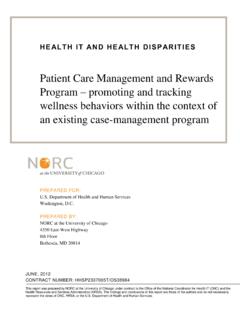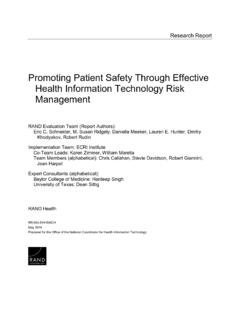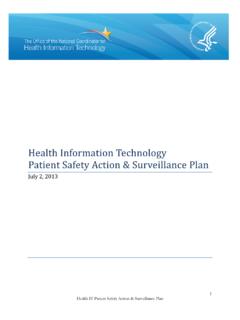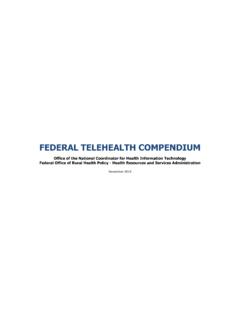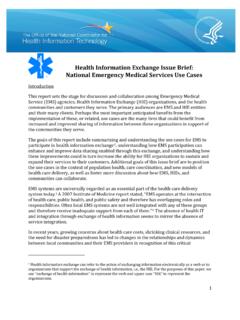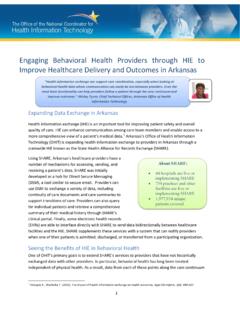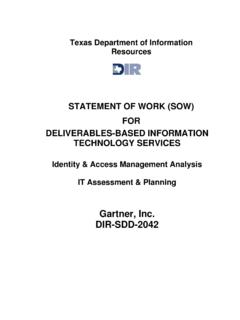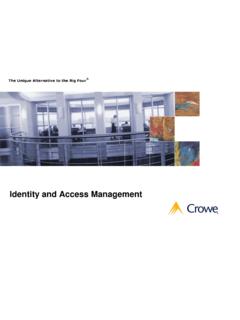Transcription of Identity and Access Management for Health Information …
1 National HIE Governance Forum Identity and Access Management for Health Information Exchange The Level of Assurance (LOA) Continuum: A resource for governing entities and their participants to examine Identity Management and progress along the LOA continuum to support secure exchange with a wider group of entities while reducing risk. December 2013 This report was prepared under the auspices of the National eHealth Collaborative through its cooperative agreement with the Office of the National Coordinator for Health Information Technology, Department of Health and Human Services. Contents I. National HIE Governance Forum .. 2 Report on Identity Management and the Level of Assurance Continuum .. Management Overview .. Gaps .. 3V.
2 Identity Management Definitions .. 3 a) Identity Proofing .. 3b)Electronic Authentication .. Requirements .. Requirements .. Efforts and Policy Recommendations .. 5a)Office of National Coordinator .. 5b)NIST .. 6c)National Strategy for Trusted Identities in 7d)Other Identity Management Efforts .. Electronic Authentication Guideline 800-63-2 .. 8X. Level of Assurance (LOA) Continuum .. 11 in Practice .. Models: Organizational LOA Considerations .. Resources .. HIE Governance Forum Participants .. 20 December 2013 - Identity and Access Management for Health Information Exchange 1 I. National HIE Governance Forum The National eHealth Collaborative (NeHC) has convened the National HIE Governance Forum at the Office of the National Coordinator for HIT s (ONC) request through ONC s cooperative agreement with NeHC.
3 The forum convenes leading Health Information exchange (HIE) governance entities to address governance issues that cross cut various exchange approaches with the goal of cultivating consistency where possible and compatibility when necessary to enable entity to entity exchange. These entities, whose decisions establish policies and practices for a given community of exchange partners at the national, state, or regional level, are working to identify key issues and common problems in the governance of Health Information exchange and the best ways to address them. The forum has utilized the ONC s Governance Framework for Trusted Electronic Health Information Exchange to guide their discussions and work. The Governance Framework reflects the principles in which ONC believes when it comes to the policy set for HIE governance.
4 This framework is intended to provide a common foundation for all types of governance models. The four key categories of principles discussed in the Governance Framework include: Organizational, Trust, Business and Technical Principles. Forum participants decided to focus on the Trust Principles for their initial discussions and work. A Steering Committee of the Forum was created to provide strategic oversight and guide the overall process. Additionally, a Privacy and Security Workgroup was established to develop specific work products for review and approval by the Forum with the intention to bring value to privacy and security aspects of Health Information exchange governance. Outcomes of the National HIE Governance Forum will be disseminated widely and are intended to accelerate entity to entity exchange in support of enhanced patient care1.
5 Report on Identity Management and the Level of AssuranceContinuumThrough discussions on common aspects and challenges of privacy and security issues, the National HIE Governance Forum participants prioritized provider Identity Management , specifically Identity proofing and electronic authentication, as an important element of trusted exchange needing industry education. This report is intended to help HIE governing entities, organizations, vendors, and providers engaging in Health Information exchange understand fundamental Identity Management issues, practices, and resources; examine Level of Assurance (LOA) aspects of Identity Management , including evolving efforts from outside of healthcare, along with business and risk ramifications of moving up the LOA continuum and shared experiences for doing so.
6 Our definitions and references to LOA are based on NIST guidance 800-63-2. As Identity Management is highly reliant on technology, it is important to note that this field is rapidly evolving as technologies mature and innovations become established in the market. This Forum report is, necessarily, a snapshot of current policies and practice. 1 The views expressed in Forum work products do not necessarily represent the views of the participants organizations. December 2013 - Identity and Access Management for Health Information Exchange 2 Management OverviewStrengthening Identity proofing and authentication controls increases confidence and assurance in an Identity s validity, and provides greater protection from unauthorized Access , which creates a strong foundation for trusted exchange.
7 Identity proofing and authentication are the first line of security defense at both the provider and organizational level and have the potential to be the weakest link in the security chain as they are the primary control which opens the door to Access Management on which many aspects of security rely. All manner of Access stems from the application of a user s credentials, if Identity proofing and authentication are not implemented effectively, there is a negative downstream effect as exchange organizations and providers make numerous decisions based on Identity within several security controls including Access , encryption, auditing, and non-repudiation (digital signatures and authentication). As electronic Health Information exchange between different organizations and providers grows, it is essential to focus on these key building blocks of security and how trust with respect to Identity controls can be improved.
8 This overview will attempt to simplify and address the key elements of Identity proofing and authentication for organizations and providers through the eyes of the National Institutes of Standards and Technology (NIST) and the Office of the National Coordinator (ONC) as well as volunteer experts from the private sector. This should assist governing entities and their participants with understanding of the need for and the process of adapting these recommendations to the Health care industry. GapsForum members agreed there is a wide disparity among their participants , end users , and vendors knowledge of Identity proofing and authentication methods, and the impact a choice of method may have on the overall level of assured protection.
9 These disparities create gaps in trust fabrics, potential security and patient-safety risks, and barriers to exchange. They saw a need for a common understanding of Identity proofing and authentication policies and methods of implementing such policies t o support efforts for exchange among trusted communities to improve patient care and more effective cost Management . V. Identity Management Definitions a) Identity ProofingIdentity proofing is the process of collecting and verifying Information about a person for the purpose of proving that a person who has requested an account, a credential, or other special privilege is indeed who he or she claims to be, and establishing a reliable relationship December 2013 - Identity and Access Management for Health Information Exchange 3 that can be trusted electronically between the individual and said credential for purposes of electronic authentication.
10 This process may include, for example, in-person evaluation of a driver s license, passport, birth certificate, or other government-issued Identity , as well as other factors specified in the individual certificate policy of the organization issuing the certificate. Identity proofing is performed before the account is created ( , portal, email), the credential is issued ( , digital certificate) or the special privilege is Identity proofing is more complex and lengthy the first time an account is created and in most cases need not be repeated in its entirety during subsequent Access , depending on the details of the relying party policy and the sensitivity and criticality of actions performed using the account. b)Electronic AuthenticationElectronic authentication (e-authentication) is the process of establishing confidence in user identities electronically presented to an Information It is the process of establishing confidence that an individual/organization using a credential that is known to the system ( , login name, digital certificate) is indeed the person/organization to whom the credential was issued.
